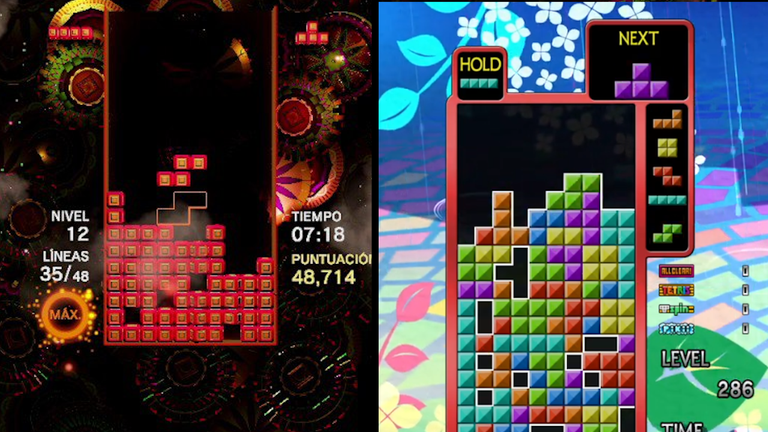

Hey there, been a good while since the last time I talked a lot about Tetris, eh?
This one is going to be a double feature, as these are two games I recently tried that obviously share the classic Tetris gameplay and are modern games available on Steam (TGM4 released this very month), but have very different approaches to what they are meant to offer because of what each one tries to evolve at.
Essentialy, Tetris Effect, a game inspired by the phenomenon of the same name, wears said inspiration through its extremely detailed presentation in the visuals and sounds to go with the flow of your gameplay along with a new Zone mechanic to infuse your experience with something beyond the stacking blocks - blocks that yet manage to stay on your focus if you are locked in to play the best you can.
And Tetris The Grandmaster 4 Absolute Eye is a very different direction of that, as while the backgrounds are colorful and the music is quite energetic, the main selling point of the TGM games ever since its inception is the steep rise in difficulty it provides by the blocks dropping faster until they are immediately on the floor, forcing players to go even faster through the Initial Rotation System mechanic (holding a button to rotate pieces BEFORE they appear), and a selection of modes that test your reflexes in different ways.
The effect of Tetris Effect
The main appeal of Tetris Effect specifically over previous Tetris games is, as I stated earlier, in its incredible presentation for a Tetris game of all things, summarized well with the main Journey mode taking you through three different styles in its first set of stages as you progress, each one having its own ambience/music and sounds to go with the visual work - sounds that also come in whenever you drop pieces and make lines as if you were adding to the sound ambence yourself.
For example, the very first stage, The Deep, which has the ambience of aquatic noises in the almost pitch black background and blue pieces dead center...
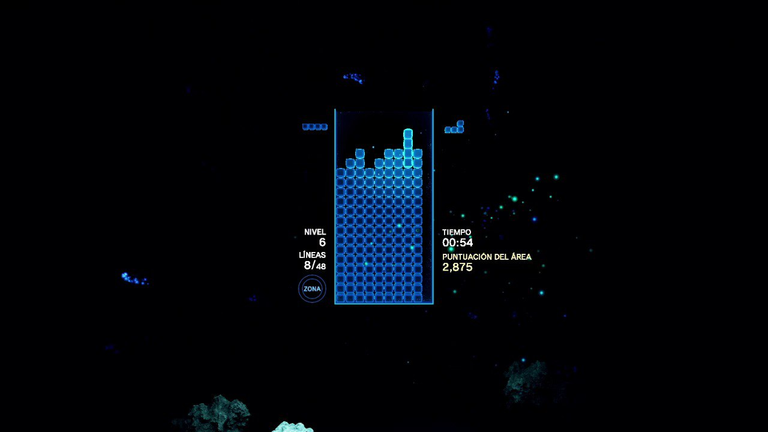
...and when you do a Tetris, the pieces you clear at the bottom create a burst of colorful particles. The ambience will also gradually change the more progress you make in that stage.
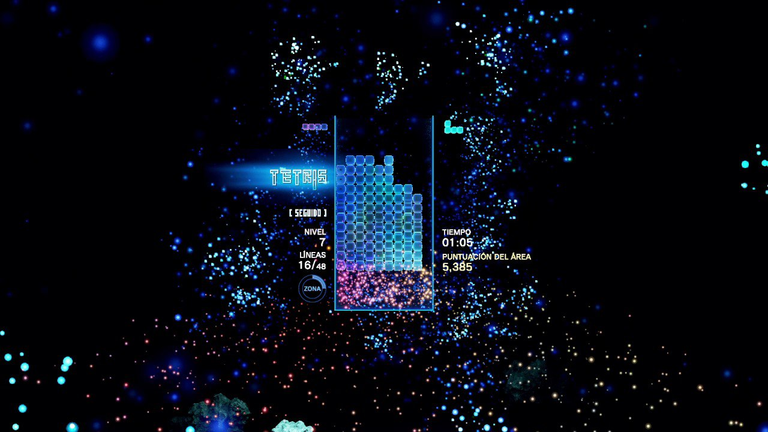
The other two stages have a very different style of the first one, which is what adds to the experience the more you move forward. But these stages will also briefly change as well the moment you can activate the Zone mechanic.
Essentially, it enables the concept of doing a "Tetris higher than 4 blocks" by stopping rows from being cleared, but as you clear more lines in this state until it ends, it will add up to a bigger bonus once it does.
So if you got 8 lines cleared during Zone, you'll get an "Octotris". Or if you do 12, a "Dodecatris."

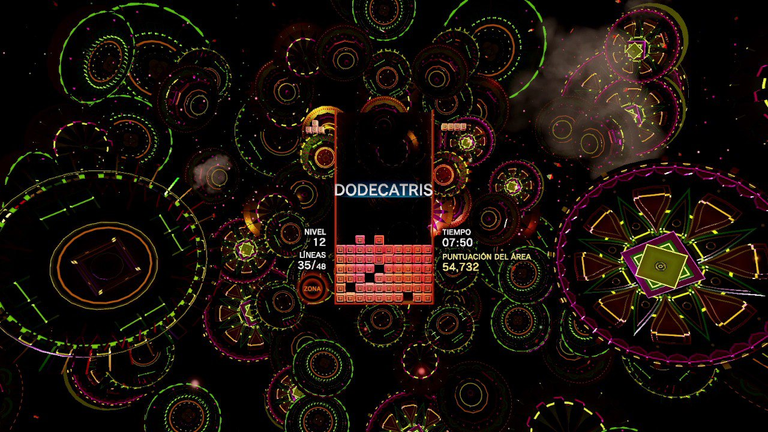
The attention to detail in presentation was done with a very specific intent too, as this game was originally released for the PS4 with integrated VR support...so you can imagine this being quite the experience if you were able to see all these backgrounds around you while you also see the Tetris board in front of you.
Curiously though, Tetris Effect Connected also has a mode that works as a perfect transition to talking about TGM: The Master mode.
Simply put, it is a mode clearly inspired by the speed of the TGM games, as pieces instantly fall to the ground from the get go, and you have to keep playing faster and faster as progress decreases the amount of time a piece can stay immobile before locking itself.
There are quite a few other modes available in the Effect menu, but this one was what stuck out first and foremost to try out because of the idea of high-speed Tetris being tempting to me to play. And just like the Journey levels, the pieces dropping and row clearing also have sounds that accompany the song that plays.
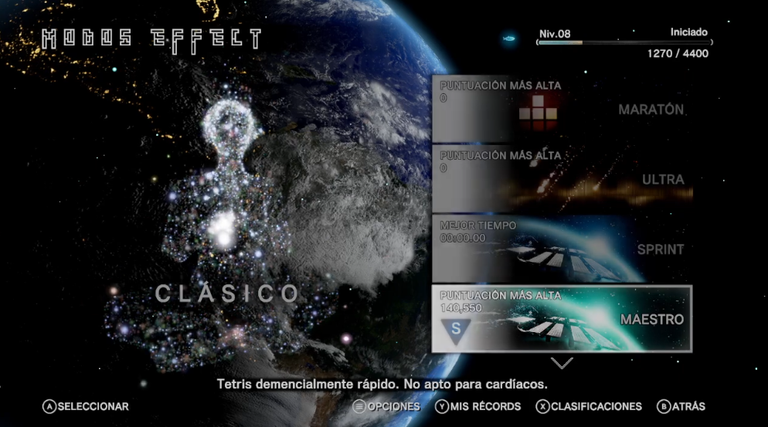
It sure is a take of maximum difficulty for a Tetris game, being effective in that goal while still being recognizable/playable as the same Tetris controls the rest of the games uses - besides the absence of the Zone mechanic, but what this mode puts further in perspective is the following:
"How can a modern Tetris game get harder than this?"
Well...
The Absolute Eye and the task of absolute perfection
The TGM games, originally locked to arcades for many years and only getting ports of the first two games for consoles a few years ago (and this fourth game being in development hell since the late 2000s until recently), are built on a very simple yet dastardly premise.
As I mentioned at the start, you get the Initial Rotation System in these games, which allows you to hold the rotate button before a piece appears to make it already appear rotated.
So if you see a I piece horizontally in the preview, holding the button to rotate it to the left before the piece appears in the field will make it appear already rotated (in this case, will appear vertically).
Sounds easy, right?
Okay big shot, now start playing at the speed of sound. Or else.
The IRS is probably the most obvious difference on the gameplay at first glance, but TGM games also use what's dubbed the Arika Rotation System (ARS), which while I'm not equipped to describe in detail, actually changes how some pieces rotate in given scenarios - which is VERY important for these games as soon as speed kicks into overdrive.
TGM games basically take advantage of the things it gives to you to enforce a demented pace, as even when it reaches 20G (instant drop), the game will also gradually reduce the time you have to move a piece before it locks itself. Sounds similar to what I described in Tetris Effect's Master Mode, but it is even worse than that.
Another side effect of ARS, which in TGM4 is what you use when you choose "TGM" mode, is that if a piece gets jammed in a bad place like this, you are screwed.
Like this S piece.

I didn't want to put it there, but the moment it fell inside, I was not allowed to rotate it out of that hole anymore.
Standard mode, which uses the common SRS style, DOES let you escape situations like that, so it is the go to way if you aren't interested or prepared to specifically learn the other rotation system - or are already used to high speed Tetris in games outside of TGM.
Funnily enough though, Standard mode locks you out of the classic normal TGM mode where you play to get a grade, instead replacing the mode with a Marathon mode that is what you expect: Clear all 150 lines. Still quite fast, but I'd say its kinda comparable to Tetris Effect's Master mode at the end - besides how here you do keep the advantage of initial rotations.
But thankfully, the other modes are also available without changes to Standard mode, those being:
- Asuka: Orange border 20G/Instant drop mode with a 7 minute timer and a 1300 level cap. It allows the usage of the Backstep button to revert a piece you've dropped for mistake correction, but even with this in mind, the speed you have to play at, the time limit and the requeriment to do a Tetris every 100 levels (from 199 onwards) still make it a big challenge.
- Konoha: Green border mode with big pieces and the goal of doing as many All Clears as possible before the time limit ends. Describes itself as the Easy mode and even offers an automatic guide that helps you with All Clears, but at a certain point the guide gets turned off...so on that moment onwards, even that will be a steep challenge unless you are very familiar with how to work with this mode.
- Shiranui: The VS CPU mode. You start at Tier 1, and whenever you beat the CPU, you unlock more tiers. Tiers are basically the CPU's difficulty, going from okay-ish at Tier 1...to the extremely skilled Tier 100.
- Master: Red border 20G/Instant drop mode. The most evil of all, not only decreasing the time to move pieces around as you progress, but in this game, adds a few new mechanics the more you keep going, like stopping a certain height of the playfield from having rows cleared.
There's definitely a lot to learn with the Grand Master games in particular, especially if you wish to thrive in this game's TGM control mode (and the third game's) or even the first two arcade game that only have that control mode available, but with how this game in particular had been stuck in development hell since 2009 (with an arcade version being unveiled back then but never releasd), this game not only is a miracle to have releaed in the first place after so long for PC, but also is definitely one that long-time TGM fans had been waiting for quite a while.
What else?
...I think that's it. Tetris Effect isn't that recent anymore but definitely looks the part even to this day, and TGM4 was that one white whale that fans of the previous three games finally got in their hansd this very month.
So...yeah, quite eventful times for Tetris enjoyers, both the casual and the hardcore - and that's only with the official games mentioned here, let alone unofficial stuff like TETRIO for online multiplayer.
Sooner or later I should also be ready to prepare a follow up to the Co-Op Quest, not only getting to show more variety of co-op games I had tried with him, but also to talk about three or four games on their own that recently have had us entertained for days straight (you know, playing through them rather than an hour or two long first taste). But until then...
Thanks for reading, and see you next time.

Spanish translation with DeepL. All screenshots were captured by myself.
Español

Hola, ha pasado un buen rato desde la última vez que hablé mucho de Tetris, ¿eh?
Este va a ser un artículo doble, ya que se trata de dos juegos que he probado recientemente y que, obviamente, comparten la jugabilidad clásica del Tetris y son juegos modernos disponibles en Steam (TGM4 ha salido este mismo mes), pero tienen enfoques muy diferentes de lo que pretenden ofrecer por lo que cada uno intenta evolucionar.
Esencialmente, Tetris Effect, un juego inspirado en el fenómeno del mismo nombre, lleva dicha inspiración a través de su presentación extremadamente detallada en los visuales y sonidos para ir con el flujo de su juego junto con una nueva mecánica de Zona para infundir su experiencia con algo más allá de los bloques de apilamiento - bloques que sin embargo se las arreglan para permanecer en su enfoque si usted está bloqueado para jugar lo mejor que pueda.
Y Tetris The Grandmaster 4 Absolute Eye es una dirección muy diferente de eso, ya que mientras que los fondos son coloridos y la música es bastante enérgica, el principal punto de venta de los juegos TGM desde sus inicios es el fuerte aumento de la dificultad que proporciona por los bloques que caen más rápido hasta que están inmediatamente en el suelo, obligando a los jugadores a ir aún más rápido a través de la mecánica del Sistema de Rotación Inicial (manteniendo pulsado un botón para girar las piezas ANTES de que aparezcan), y una selección de modos que ponen a prueba tus reflejos de diferentes maneras.
El efecto de Tetris Effect
El principal atractivo de Tetris Effect con respecto a anteriores juegos de Tetris reside, como ya he dicho, en su increíble presentación para tratarse de un juego de Tetris, que se resume muy bien en el modo principal Journey, que te lleva a través de tres estilos diferentes en su primera serie de fases a medida que avanzas, cada una con su propia ambientación/música y sonidos que acompañan al trabajo visual - sonidos que también aparecen cada vez que dejas caer piezas y haces líneas como si tú mismo estuvieras añadiendo sonido a la ambientación.
Por ejemplo, el primer escenario, Las Profundidades, tiene un ambiente de ruidos acuáticos en un fondo casi negro y piezas azules en el centro...

...y cuando haces un Tetris, las piezas que eliminas en la parte inferior crean una explosión de partículas de colores. El ambiente también cambiará gradualmente cuanto más avances en esa fase.

Las otras dos fases tienen un estilo muy diferente de la primera, lo que aumenta la experiencia cuanto más avanzas. Pero estas fases también cambiarán brevemente en el momento en que puedas activar la mecánica de Zona.
Básicamente, activa el concepto de hacer un «Tetris superior a 4 bloques» impidiendo que se despejen filas, pero a medida que despejes más líneas en este estado hasta que termine, se sumará una bonificación mayor una vez que lo haga.
Así que si consigues despejar 8 líneas durante la Zona, obtendrás un «Octotris». O si haces 12, un «Dodecatris».


La atención al detalle en la presentación también se hizo con una intención muy específica, ya que este juego se lanzó originalmente para la PS4 con soporte de RV integrado... así que puedes imaginarte que sería toda una experiencia si pudieras ver todos estos fondos a tu alrededor mientras ves también el tablero de Tetris frente a ti.
Aunque curiosamente, Tetris Effect Connected también tiene un modo que funciona como transición perfecta para hablar de TGM: el modo Maestro.
En pocas palabras, es un modo claramente inspirado en la velocidad de los juegos TGM, ya que las piezas caen instantáneamente al suelo desde el primer momento, y tienes que seguir jugando cada vez más rápido a medida que el progreso disminuye la cantidad de tiempo que una pieza puede permanecer inmóvil antes de bloquearse.
Hay bastantes modos más disponibles en el menú Efecto, pero este fue el que me llamó la atención en primer lugar para probarlo, ya que la idea de jugar al Tetris a alta velocidad me resultaba tentadora. Y al igual que en los niveles de Journey, la caída de piezas y la eliminación de filas también tienen sonidos que acompañan a la canción que suena.

Sin duda es una toma de máxima dificultad para un juego de Tetris, siendo eficaz en ese objetivo sin dejar de ser reconocible/jugable como los mismos controles de Tetris que el resto de juegos utiliza - además de la ausencia de la mecánica de Zona, pero lo que este modo pone aún más en perspectiva es lo siguiente:
«¿Cómo puede un juego de Tetris moderno ser más difícil que esto?».
Pues...
The Absolute Eye y la tarea de la perfección absoluta
Los juegos de TGM, originalmente restringidos a los salones recreativos durante muchos años y que sólo recibieron ports de los dos primeros juegos para consolas hace unos años (y este cuarto juego estando en el infierno del desarrollo desde finales de la década de 2000 hasta hace poco), están construidos sobre una premisa muy simple pero ruin.
Como mencioné al principio, en estos juegos tienes el Sistema de Rotación Inicial, que te permite mantener pulsado el botón de rotación antes de que aparezca una pieza para que ya aparezca rotada.
Así que si ves una pieza I horizontal en la vista previa, mantener pulsado el botón para rotarla a la izquierda antes de que la pieza aparezca en el campo hará que aparezca ya rotada (en este caso, aparecerá verticalmente).
Suena fácil, ¿verdad?
Está bien pez gordo, ahora empieza a jugar a la velocidad del sonido. O si no...
El IRS es probablemente la diferencia más obvia en la jugabilidad a primera vista, pero los juegos TGM también utilizan lo que se denomina el Sistema de Rotación Arika (ARS), que aunque no estoy equipado para describir en detalle, en realidad cambia la forma en que algunas piezas giran en determinados escenarios - lo cual es MUY importante para estos juegos en cuanto la velocidad se dispara.
Los juegos TGM básicamente se aprovechan de las cosas que te da para imponer un ritmo demencial, ya que incluso cuando llega a 20G (caída instantánea), el juego también reducirá gradualmente el tiempo que tienes para mover una pieza antes de que se bloquee. Suena parecido a lo que describí en el Modo Maestro de Tetris Effect, pero es incluso peor que eso.
Otro efecto secundario del ARS, que en TGM4 es lo que usas cuando eliges el modo «TGM», es que si una pieza se atasca en un mal sitio como este, estás jodido.
Como esta pieza S.

Yo no quería ponerla ahí, pero en el momento en que cayó dentro, ya no pude girarla más para sacarla de ese agujero.
El modo Estándar, que usa el estilo SRS común, SÍ te permite escapar de situaciones como esa, así que es el modo al que acudir si no estás interesado o preparado para aprender específicamente el otro sistema de rotación - o si ya estás acostumbrado al Tetris de alta velocidad en juegos fuera de TGM.
Sin embargo, curiosamente, el modo Estándar te deja fuera del clásico modo TGM normal en el que juegas para conseguir una nota, sustituyendo el modo por un modo Maratón que es lo que esperas: Completa las 150 líneas. Sigue siendo bastante rápido, pero yo diría que al final es un poco comparable al modo Maestro de Tetris Effect, además de que aquí conservas la ventaja de las rotaciones iniciales.
Pero por suerte, los otros modos también están disponibles sin cambios en el modo Estándar, que son:
- Asuka: Borde naranja 20G/modo de caída instantánea con un temporizador de 7 minutos y un tope de nivel de 1300. Permite el uso del botón Backstep para revertir una pieza que hayas tirado para corregir errores, pero incluso teniendo esto en cuenta, la velocidad a la que tienes que jugar, el límite de tiempo y el requerimiento de hacer un Tetris cada 100 niveles (a partir del 199) lo siguen convirtiendo en un gran reto.
- Konoha: Modo de borde verde con piezas grandes y el objetivo de hacer tantos All Clears como sea posible antes de que termine el límite de tiempo. Se describe a sí mismo como el modo Fácil e incluso ofrece una guía automática que te ayuda con los All Clears, pero en cierto punto la guía se desactiva... así que a partir de ese momento, incluso eso será un gran reto a menos que estés muy familiarizado con cómo funciona este modo.
- Shiranui: El modo VS CPU. Empiezas en el nivel 1, y cada vez que vences a la CPU, desbloqueas más niveles. Los niveles son básicamente la dificultad de la CPU, que va desde un nivel 1 aceptable hasta un nivel 100 extremadamente hábil.
- Maestro: Borde rojo 20G/Modo de caída instantánea. El más malvado de todos, no solo disminuye el tiempo para mover las piezas a medida que avanzas, sino que en este juego añade algunas mecánicas nuevas cuanto más avanzas, como impedir que se despejen las filas de una determinada altura del campo de juego.
Definitivamente, hay mucho que aprender de los juegos Grand Master en particular, especialmente si deseas prosperar en el modo de control TGM de este juego (y del tercer juego) o incluso de los dos primeros juegos arcade que solo tienen ese modo de control disponible, pero con la forma en que este juego en particular se había quedado atascado en el infierno de desarrollo desde 2009 (con una versión arcade que se dio a conocer en ese entonces, pero nunca liberado), este juego no sólo es un milagro haber liberado en primer lugar después de tanto tiempo para PC, pero también es definitivamente uno que los fans de TGM desde hace mucho tiempo habían estado esperando durante bastante tiempo.
¿Qué más?
...Creo que eso es todo. Tetris Effect ya no es tan reciente, pero sin duda sigue pareciendo el mismo, y TGM4 fue la ballena blanca que los fans de los tres juegos anteriores finalmente tuvieron en sus manos este mismo mes.
Así que... sí, corren tiempos moviditos para los aficionados al Tetris, tanto los ocasionales como los más acérrimos, y eso sólo con los juegos oficiales mencionados aquí, por no hablar de cosas no oficiales como TETRIO para multijugador en línea.
Tarde o temprano también debería estar listo para preparar una continuación del Co-Op Quest, no sólo llegando a mostrar más variedad de juegos cooperativos que había probado con él, sino también para hablar de tres o cuatro juegos por sí solos que últimamente nos han tenido entretenidos durante días seguidos (ya sabéis, jugando a través de ellos en lugar de una primera cata de una hora o dos). Pero hasta entonces...
Gracias por leer, y hasta la próxima.

Traducción al español hecha con DeepL. Todas las fotos capturadas por mí.
La primera vez que oí de esto, no entendía muy bien porque la gente lo trataba como un juego distinto, al llamarse Tetris me imaginaba era lo mismo de siempre, con algún retoque visual. Pero cuando lo busqué y vi lo que era dije; Ok, esto es otra cosa. De alguna forma logra hacer que todo se sienta épico, recuerdo un nivel donde comienzan a salir unas sirenas a los lados hechas de luz y es como estar en un viaje psicodélico jaja.
La verdad quedé igual cuando probé el modo Journey pro primera vez - aún tengo que darle otra vuelta pero ya tengo claro que va a ser igual de interesante en los niveles que vienen.
Gracias por leer y por tu comentario :]
I remember years ago when I had to take Zolpidem to sleep, and just before it knocks you out it gets you high as shit.
In between being awake and asleep, I'd play Tetris Effect. It was so trippy xD
It's still my favourite Tetris game, specially because of the zone mechanic, which can lead to spectacular comebacks in local multiplayer when playing with my cousin :P
I did try tetris Effects as it was part of playstation plus. Aside from this I still just like either the NES or Gameboy version the most. Puyo Puyp tetris is also fun the play with 2 and so is Tiny Towers which is a twist on tetris where the blocks aren't stable.
Tetris really remains a classic I will never get bored of. This is the first time I hear of Tetris TGM4